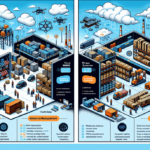Comparing SAP Extended Warehouse Management (EWM) and Oracle Warehouse Management Cloud (WMS)
Warehouse management software (WMS) is becoming an essential tool for businesses to manage their inventory, shipping, receiving, and overall warehouse operations. With the rise of e-commerce and the increasing need for efficient supply chain management, it's crucial for companies to choose the right WMS that meets their specific needs and requirements. Two of the most popular WMS solutions available in the market are SAP Extended Warehouse Management (EWM) and Oracle Warehouse Management Cloud (WMS). This comprehensive guide compares these two WMS solutions in terms of features, deployment options, costs, user interface, integration capabilities, customer support, industry-specific features, and more.
Understanding Warehouse Management Software
Warehouse management software is a tool that helps businesses oversee every aspect of their warehouse operations, from receiving to shipping. It utilizes technologies such as barcode scanning, RFID, and automation to ensure accurate tracking of items throughout the warehouse. According to a Gartner report, the global WMS market is expected to reach $31 billion by 2023, highlighting its growing importance.
Key Benefits of WMS
- Real-Time Inventory Visibility: Allows businesses to monitor inventory levels and movements in real-time, facilitating informed decision-making.
- Integration Capabilities: Seamlessly connects with other systems like Transportation Management Systems (TMS) and Enterprise Resource Planning (ERP) systems.
- Operational Efficiency: Optimizes inventory levels, reduces errors, and streamlines warehouse operations, leading to cost savings.
Effective WMS implementation can lead to significant improvements in inventory accuracy, order fulfillment rates, and overall warehouse productivity.
Features and Capabilities
SAP Extended Warehouse Management (EWM)
SAP EWM offers comprehensive functionalities for businesses of all sizes. Key features include:
- Real-Time Inventory Management: Provides up-to-the-minute visibility into inventory levels and locations.
- Labor Management: Optimizes workforce allocation and productivity through detailed labor tracking.
- Advanced Picking Strategies: Supports various picking methods to enhance order accuracy and speed.
- Integration with SAP ERP: Seamlessly integrates with other SAP products, facilitating unified business processes.
- Warehouse Automation: Incorporates technologies like voice-enabled operations and mobile applications.
SAP EWM is ideal for businesses with complex warehouse operations, supporting multiple warehouses and diverse inventory.
Oracle Warehouse Management Cloud (WMS)
Oracle WMS is a cloud-based solution offering advanced features such as:
- Inventory and Order Management: Efficiently manages inventory levels and order processing.
- Wave Management: Optimizes the grouping of orders for efficient picking and shipping.
- Quality Control: Ensures that products meet quality standards before shipping.
- Integration with Oracle SCM: Easily integrates with other Oracle Supply Chain Management applications.
- Mobile Accessibility: Allows warehouse workers to access information and perform tasks on the go.
Oracle WMS is known for its scalability and flexibility, making it suitable for rapidly growing businesses.
Deployment Options and Total Cost of Ownership
Deployment Options
SAP EWM is typically deployed as an on-premises solution, requiring installation on the company's servers. This offers greater control and customization but involves higher upfront costs and maintenance responsibilities. Conversely, Oracle WMS is a cloud-based solution accessible via web browsers, offering flexibility and scalability with lower initial investments.
Total Cost of Ownership
The total cost of ownership (TCO) for both SAP EWM and Oracle WMS varies based on factors like business size, number of users, and required features. Generally:
- SAP EWM: Higher initial costs due to on-premises deployment, but offers extensive customization and advanced features.
- Oracle WMS: Lower upfront costs with a subscription-based model, but ongoing subscription fees can increase the TCO over time.
Businesses should consider both initial implementation costs and long-term maintenance when evaluating TCO.
User Experience and Integration Capabilities
User Interface
User interface (UI) is crucial for the adoption and efficiency of WMS. SAP EWM has a robust but complex UI, offering extensive customization to meet specific business needs. Oracle WMS features a more intuitive and user-friendly interface, which can lead to faster user adoption and reduced training times.
Integration with Other Business Applications
Both SAP EWM and Oracle WMS offer strong integration capabilities:
- SAP EWM: Excels in integrating with other SAP products like SAP ERP and SAP Supply Chain Management, ensuring unified data flow across systems.
- Oracle WMS: Integrates seamlessly with Oracle's suite of applications and supports third-party integrations, providing flexibility for diverse IT environments.
Choosing a WMS that integrates well with existing business applications is essential for seamless operations and data consistency.
Customer Support and Industry-Specific Features
Customer Support and Services
Effective customer support is vital for successful WMS implementation and ongoing operations. Both SAP and Oracle offer comprehensive support options, including:
- 24/7 technical support via phone, email, and chat.
- Extensive training programs and certification courses.
- Access to online resources, including documentation and user communities.
Businesses should evaluate the quality and responsiveness of support services when selecting a WMS provider.
Industry-Specific Features
Different industries have unique warehouse management needs. Both SAP EWM and Oracle WMS offer tailored functionalities for various sectors:
- Retail: Both solutions support high-volume order fulfillment and omni-channel inventory management.
- Manufacturing: Features like advanced inventory tracking and integration with production systems are essential.
- Logistics: Robust transportation management and real-time tracking capabilities are crucial.
Assessing how well a WMS aligns with industry-specific requirements can significantly impact operational efficiency.
Making the Right Choice for Your Business
Choosing the Right Warehouse Management Solution
Selecting between SAP EWM and Oracle WMS depends on various factors:
- Business Size and Complexity: SAP EWM is well-suited for large enterprises with complex warehouse operations, while Oracle WMS is ideal for growing businesses seeking scalability.
- Budget Considerations: Organizations with higher budgets may prefer SAP EWM for its advanced features, whereas those looking for cost-effective solutions might opt for Oracle WMS.
- Integration Needs: Companies heavily invested in SAP or Oracle ecosystems should choose the respective WMS to leverage existing integrations.
- User Experience: Businesses prioritizing ease of use may favor Oracle WMS’s intuitive interface.
Key Takeaways
In summary, both SAP EWM and Oracle WMS are powerful warehouse management solutions with distinct strengths:
- SAP EWM: Offers advanced features, extensive customization, and seamless integration within the SAP ecosystem, making it suitable for large and complex operations.
- Oracle WMS: Provides a user-friendly interface, scalability, and flexibility, ideal for rapidly growing businesses and those seeking cloud-based solutions.
Carefully evaluating your business needs, budget, and existing IT infrastructure will help in making an informed decision.
Future Trends in Warehouse Management Software
The warehouse management landscape is evolving with emerging technologies. Future trends include:
- Increased Automation and Robotics: Enhancing efficiency and reducing labor costs.
- Artificial Intelligence and Machine Learning: Improving demand forecasting and inventory optimization.
- IoT Integration: Enabling real-time tracking and smart sensor deployments.
Both SAP EWM and Oracle WMS are expected to incorporate these advancements, providing businesses with cutting-edge tools to stay competitive.
Implementation Best Practices
To ensure successful deployment of warehouse management software, consider the following best practices:
- Thorough Planning: Define clear objectives and requirements before implementation.
- Stakeholder Involvement: Engage all relevant parties to ensure buy-in and address concerns.
- Vendor Selection: Choose a vendor that aligns with your business needs and offers robust support.
- Comprehensive Training: Invest in training programs to ensure users are proficient with the new system.
- Continuous Monitoring: Regularly assess system performance and make necessary adjustments.
Following these best practices can lead to a smooth implementation process and maximize the benefits of your chosen WMS.
Conclusion
Choosing the right warehouse management software is a crucial decision that can significantly impact the efficiency and profitability of your business. By understanding the features, deployment options, costs, user experience, and support services of SAP EWM and Oracle WMS, you can make an informed choice that aligns with your specific business needs and long-term goals.




















